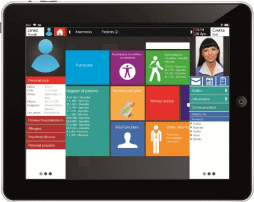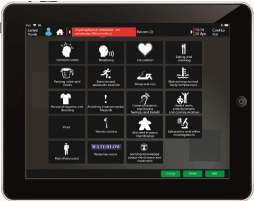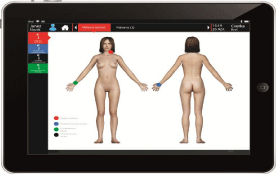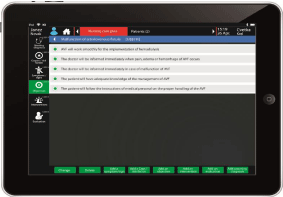
Research Article
Austin J Nephrol Hypertens. 2016; 3(1): 1054.
Model of Electronic Nursing Care Record for Patients with Vascular Access Malfunction
Krel C1, Rajkovic V2, Benedik P3 and Bevc S1*
1Department of Nephrology, Clinic for Internal Medicine, University Medical Centre, Slovenia
2Department of Organizational Sciences, University of Maribor, Slovenia
3Department of Organizational Sciences, University of SRC Infonet d.o.o., Slovenia
*Corresponding author: Sebastjan Bevc, Department of Nephrology, Clinic for Internal Medicine, University Medical Centre, Maribor, Slovenia
Received: May 12, 2016; Accepted: June 25, 2016; Published: June 27, 2016
Abstract
Background: Electronic documentation of nursing care data requires unified documentation, data standards, adequately accessible information technology and existing legislation. The aim of the study was to determine the role of electronic nursing care record in evaluation of patients with vascular access malfunction.
Methods: Ten hospitalized patients with end-stage renal disease were enrolled in our study. Five nurses evaluated patients’ problems with vascular access using the model of electronic nursing care record for nursing diagnosis of vascular access malfunction. The model has been tested with mobile device - tablet computers. After the patients conditions were evaluated, interviews with nurses about functionality of the model of electronic nursing care record were performed. The answers were analyzed using SWOT (Strengths, Weaknesses, Opportunities and Threats) analysis.
Results: Our study shows that electronic nursing care record ensures an efficient evaluation of a patient for a single nursing diagnosis in all process phases of nursing care. Using electronic record, nurses systematically collect and manually enter data into a mobile device next to a patient’s bed and therefore increase accuracy of nursing care record. The electronic record sufficiently includes all data about venous accesses and vital signs at a single access point. The screen of a mobile device enables quick access to information about patients’ medical data and therefore quicker nurse’s response.
Conclusions: The results of our study encourage us to further develop electronic nursing care record also for other nursing diagnoses in the field of nephrology and to implement e-documentation in daily clinical practice.
Keywords: Electronic health record; Nephrology; Vascular access
Introduction
In the technology-rich environment of healthcare, hospital documentation systems need to be developed so that quality benefits are realized and are more evident. Usefulness and documentation accuracy of an information system are very important [1]. Systematic, professional and quality nursing care work is based on good documentation and patient’s treatment according to a process method of work. Documentation of nursing care is essential in order to ensure quality care, risk management, to prevent and reduce exposure to the judicial and disciplinary procedures and to ensure accreditation requirements. Nursing care documentation also provide the continuity of nursing care, nursing care process, safety for the patient and participating in the health care team, regular education, research and development [2]. The basis of a nursing care electronic record lies in a unified terminology, standards of nursing care, accessible information technology and existing legislation. The use of standardized nursing terminologies improved nursing content in the nursing care plans. Moreover, computerized nursing care plans, in comparison with handwritten and pre-printed care plans, increased documentation completeness [3]. Nowadays, health information technology and electronic health records are tools to improve communication and documentation and health care outcomes and some authors already reported clear benefits of nursing care electronic record compare to usual paper form [4,5].
The aim of our study was to evaluate the strengths and weaknesses of nursing documentation in paper or electronic form, and to identify the usefulness of mobile information technology (tablet computers) for the documentation of vascular access.
Methods
During six months in year 2012 ten hospitalized patients with end-stage renal disease were enrolled in our study. All patients were hospitalized on Department of nephrology at Clinic for Internal medicine, University medical centre Maribor, because of malfunction of arterio-venous fistula. Five nurses evaluated patients’ problems with vascular access using the model of electronic nursing care record for nursing diagnosis of vascular access malfunction. The model was tested by the registered nurses of at least five years of work experience. Nurses were professionally qualified to perform nursing care for patients with end-stage renal disease. The model has been tested with mobile devices - tablet computers. The prototype of the electronic nursing care record has been installed on one stationary computer (in nurse working area) and on one tablet computer. Nurses were entering data on the spot while taking care of the patient and later in the working area. After the patients conditions were evaluated, interviews with nurses about functionality of the model of electronic nursing care record were performed. The answers were analyzed using SWOT (Strengths, Weaknesses, Opportunities and Threats) analysis.
For study purposes only specific screen windows on portable device (tablet computer) were designed (Figure 1-6). After the entry window, secured with personal password, the nurses could entered into Main menu window (Figure 1) divided into the left part (patient data: personal data, allergies, prosthetic devices, personal property), the middle part (menus: plan of nursing care, psychophysical condition - on admission (Figure 2), psychophysical condition - hospital day care, venous access, register of patients, vital functions, some other information) and on the right part (data about nurse personal data). Next step was to mark and define the venous access with the color and insert some additional data about the access (Figure 3). Further, we formed a nursing diagnosis - malfunction of arterio-venous fistula and prepared the nursing care plan. With our model we could easily check the possible causes and risk factors for arterio-venous malfunction mark the signs and symptoms and define the objectives of nursing (Figure 4). Then, the nurses set measurable and achievable short- and long-range goals for the patient and implemented interventions (Figure 5). Finally, evaluation of nursing care is performed (Figure 6). With our model the patient’s status and the effectiveness of the nursing care can be continuously evaluated, and the care plan modified as needed.

Figure 1: Main menu window.

Figure 2: Psychophysical condition - on admission (life activities).

Figure 3: Venous access: dialysis catheter (marked with the red color),
peripheral venous access (blue color), arterio venous fistula (green color)
and central venous access (black color).

Figure 4: The objectives of nursing.

Figure 5: Planning interventions.

Figure 6: Evaluation of nursing care.
Because of the technical reasons (nonmedical support by using our model of electronic nursing care record) our study was time limited and was performed only for half year on first 10 patients accepted at our Department of nephrology because of problems with vascular access in this period of time.
Results
The results of our study showed that electronic nursing care record ensures an efficient evaluation of a patient for a single nursing diagnosis in all process phases of nursing care. Using electronic record, nurses systematically collect and manually enter data into a mobile device next to a patient’s bed and therefore increase accuracy of nursing care record. The electronic record sufficiently includes data about venous accesses and vital signs at a single access point. The screen of a mobile device enables quick access to information about patients’ medical data and therefore quicker nurse’s response. The nurses could clearly documented implementation of nurse interventions and evaluated their work. After the patients conditions were evaluated, interviews with nurses about functionality of the model of electronic nursing care record were performed and the SWOT analysis is presented in Table 1.
Strengths:
- data entered on the spot, next to patient's bed,
- easy and quick access to information about the patient, analysis and decision support,
- consideration of the patient after the process of nursing care,
- rationalization of work,
- prevent loss of data between health care,
- integration scatter in the data from of the various existing forms,
- there is no duplication of nursing documentation,
- in re-hospitalization would not be necessary to look for documentation in the central archive administration
Weaknesses:
- electronic record includes a narrow set of data, depending on the characteristics of end-stage renal disease patient treatment and probationary covers only one nursing diagnosis,
- covers only the data which relate to nursing care and treatments that are not covered by other performers of health care team,
- the application does not allow data to be printed on paper,
- no connection with the hospital information system
Opportunities:
- the solution is a good basis for further development of e-nursing documentation
Threats:
- costs are too high for the introduction of software solutions (ICT)
- involves too much work with the computer rather than the patient,
- aversion of nursing personnel, especially of nurses, who do not have computer knowledge,
- reduction of professional attention and critical thinking
Table 1: The SWOT analysis.
Discussion
The introduction of mobile information technology in health care helps to expedite obtaining information data. Electronic documentation of nursing care data allows direct access to patient data and enable immediate data input by the services provided, all of which affect the appropriate documentation and effectiveness of health care [6]. In our study we confirmed the efficiency of the model of electronic nursing care record in patients with vascular access malfunction. According to SWOT analysis we concluded that electronic nursing documentation has many strengths but also some weaknesses. However, electronic documentation of nursing care data requires unified documentation, data standards, adequately accessible information technology and existing legislation and is more appropriately designed as documenting the monitoring of vascular access in a paper form. Despite the extent to which electronic nursing documentation improves the quality of care to hospitalized patients remains unknown, in part due to the lack of effective comparisons with paper-based nursing documentation [7]. The model of electronic documentation is graphically attractive and transparently designed. In our study we focused on the end-stage renal disease patients with arterio-venous fistula malfunction, but the mobile device could be useful also for other types of vascular access. With our software program we can easily mark a dialysis catheter and define malfunction, intervention and evaluation. Data is time-transparently entered if he was having fever, occurrence of pus, redness. Using electronic documentation is time-consuming. The effectiveness of documentation and quality of nursing care also affects the education of nurses. It is necessary to focus on the education of staff, as only a long experience and knowledge of nurses’ information technologies are not sufficient to raise the quality of documentation and patient nursing care [8]. Regarding field of nephrology and dialysis, it is necessary to continue the education of nurses in nursing care of the patient with renal disease. The nurses need the basic knowledge of the renal diseases and dialysis to be able to sufficiently observe complications during the treatment and response appropriately. The knowledge and the awareness of benefits of electronic documentation can help us to increase the quality of evaluation also patient with vascular access malfunction. The further development of nursing documentation, which will contain constructed nursing diagnosis and plan of nursing care, is necessary. Since the nurses are frequently dealing with patients also with acute and chronic kidney disease who need temporally dialysis catheter, the modification of the software is crucial. Properly designed documentation helps to reduce the occurrence of malfunctioning venous access, and properly document all activities of life in the patient. Analysis of our experience showed that our model is structured accordingly for its development in the future. We found that the model ensures the applicability of the chosen design and the user-friendly (unambiguous commands, colors, dynamically adapting the content).
Conclusions
The results of our study encourage us to further develop electronic nursing care record also for other nursing diagnoses in the field of nephrology and to implement electronic documentation in daily clinical practice. With the appropriate documentation we can provide a safe nursing care to the patients, and protection of patients’ rights. Moreover, appropriate electronic nursing care records also provide protection of nurses work performed and their evaluation.
References
- Mcdowell DE, Dillon TW, Lending D. Perceived Quality Benefits Influenced by Usefulness and Documentation Accuracy of Information Systems. Comput Infor Nurs. 2008; 26: 350-357.
- Keenan GM, Yakel E, Tschannen D, Mandeville M. Documentation and the Nurse Care Planning Process. Hughes RG (editor). In: Patient Safety and Quality: An Evidence-Based Handbook for Nurses. Rockville (MD): Agency for Healthcare Research and Quality (US); 2008.
- Thoroddsen A, Ehnfors M., Ehrenberg A. Content and Completeness of Care Plans after Implementation of Standardized Nursing Terminologies and Computerized Records. Comput Inform Nurs. 2011; 29: 599-607.
- Choi J, Chun J, Lee K, Lee S, Shin D, Hyun S, et al. Mobile Nurse: handheld information system for point of nursing care. Comput Methods Programs Biomed. 2004; 74: 245-254.
- Sheridan S. The implementation and sustainability of electronic health records. Online Journal of Nursing Informatics. 2012; 16.
- Hsiao JL, Chen RF. An Investigation on Task-Technology Fit of Mobile Nursing Information Systems for Nursing Performance. Comput Inform Nurs. 2012; 30: 265-273.
- Kelly TF, Brandon DH, Docherty SL. Electronic nursing documentation as a strategy to improve quality of patient care. J Nurs Scholarsh. 2011; 43: 154-162.
- Fujino Y, Kawamoto R. Effect of Information and Communication Technology on Nursing Performance. Comput Inform Nurs. 2013; 31: 244-250.